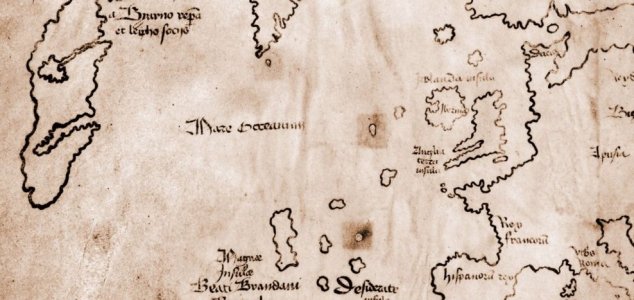
Posted on 09/20/2021 7:59:38 AM PDT by BenLurkin
1957, was donated to Yale in the 1960s where it immediately came under a great deal of suspicion and intrigue.
Alleged to date back to the 15th-Century, the map depicts 'Vinlanda Insula' - a section of North America's coastline. It also claims that the region was visited by Europeans in the 11th Century.
Despite appearing outwardly genuine, the map has been mired in controversy ever since it first appeared. Previous studies have indicated the presence of modern ink on its parchment, however it wasn't until Yale researchers were able to apply modern tools and techniques that it was possible to determine once and for all that the entire thing was a complete forgery.

(Excerpt) Read more at unexplained-mysteries.com ...
ping
Looks like a drawing of blood plasma.
Wait, no. It’s single-cell Beavis and Butthead.
If it has lasted 60 years before being proved false then one has to say that it is a ‘good’ fake! So many times a ‘discovery’ turns into a broken heart but those stories of documents & paintings from attics & closets turning into windfalls keeps the optimist going!
I once turned down a low price on a 14th Century Samurai Sword because it was too good to be true. I will never know but even if it had been true, where would I store it or who would I donate it to?
Still, thanks for this post, I’ve known about this controversy for years / decades and it is interesting to see it ‘resolved’!
What next? Will they try to show that the Kensington Runestone is a fake too?
That “Bust of Nefertiti” that the Germans “found.”
That and the even smaller notation:
#wefoundamericafirst; wefoundamericafirst.com
Thanks BenLurkin. The previous "debunking" -- the presence of anatase -- was itself debunked when titanium in older, authentic documents was uncovered. Of course, that research might not have taken place had it not been for the claim about the Vinland map.

Al,gore Invented maps
Me too but I am shocked it is a fake
EIRIKR (Eric) upsi GNUPSSON, bishop; fl. 1121.
Dictionary of Canadian Biography
Volume I (1000-1700)
http://www.biographi.ca/en/bio/eirikr_gnupsson_1E.html
Almost nothing is known of this man. Icelandic annals s.a. 1113 record “Voyage of Bishop Eric” and s.a. 1121 “Bishop Eric from Greenland went to look for Vinland.” Claus C. Lyschander (1558–1624), not a very trustworthy source, says that he went to Vinland and there planted both the faith and a colony which still exist. Beyond this nothing is known of Bishop Eric except his genealogy and Lyschander says that he was buried at Gardar in Greenland in 1146. This paucity of information has, however, not prevented much writing and speculation: that Eric was bishop of Greenland and Vinland; that knowledge of the location of Vinland had been lost and Eric went to find it; that Vinland was an old colony and Eric was making a visitation to part of his diocese; that he was seeking to convert pagans to Christianity or regain apostates for the faith; that vestiges of the Christian faith supposedly found in the 16th century among the Indians of Quebec and the Atlantic Provinces stem from Eric’s work. Yet all that is known is that Eric went in search of Vinland, wheresoever it may have been.
T. J. Oleson
Hennig, Terrae incognitae, III, passim. C. C. Lyschander, Dend Grpnlanske chronica (Kpbenhavn, 1726). Oleson, Early voyages, 100. P. de Roo, History of America before Columbus according to documents and approved authors (2v., London, 1900).
what gave it away?
maybe the “Made in China” tag at the bottom ?
maybe the “Made in China” tag at the bottom ?
China is red
Soylent is green
They want us all dead
So COVID-19
could be
Because of the compound in the inks? It could be a forgery. But it could also be that someone freshened it up in the 1920s, back when people were very fast and loose with antiquities.
Look up the famous photos of cranes being used to assemble those rocks on top of Stonehenge in 1901.
That doesn’t make Stonehenge a forgery.
And then we must consider modern Ivy colleges that are completely horny to discredit ANYTHING white or European origin.
So basically, I remain to be convinced that the Yale declaration forgery is not another kind of forgery.
https://en.wikipedia.org/wiki/L%27Anse_aux_Meadows
This settlement was discovered on Newfoundland in 1960. So how did the supposed 1920s faker know that the region was visited in the exact century before that was known or confirmed?
From the article;
“Alleged to date back to the 15th-Century, the map depicts ‘Vinlanda Insula’ - a section of North America’s coastline. It also claims that the region was visited by Europeans in the 11th Century.”
Disclaimer: Opinions posted on Free Republic are those of the individual posters and do not necessarily represent the opinion of Free Republic or its management. All materials posted herein are protected by copyright law and the exemption for fair use of copyrighted works.